“The Uttar Pradesh government is harnessing social media to promote its youth-centric schemes, targeting millions of young voters with dynamic ad campaigns. From skill development to entrepreneurship, these initiatives aim to empower the state’s youth. However, experts highlight challenges like digital reach and misinformation risks, urging a balanced approach to ensure effective engagement and transparency.”
Uttar Pradesh Taps Social Media to Boost Youth Welfare Programs
In a bid to connect with its young population, the Uttar Pradesh (UP) government has launched an ambitious social media advertising campaign to promote its youth-focused welfare schemes. With over 65% of India’s population under 35 and UP being home to a significant portion of this demographic, the state is strategically using platforms like Facebook, Instagram, YouTube, and X to reach tech-savvy youth. As of August 2025, UP’s campaigns have garnered millions of impressions, leveraging influencers, short videos, and interactive content to highlight programs like the Mukhyamantri Yuva Swarozgar Yojana and skill development initiatives.
The state’s flagship Mukhyamantri Yuva Swarozgar Yojana, aimed at fostering entrepreneurship, has been a focal point of these ads. Recent data from the UP government’s portal indicates over 1.2 lakh applications were received for the scheme in 2024-25, with social media credited for a 30% spike in registrations compared to the previous year. Campaigns feature relatable narratives, showcasing success stories of young entrepreneurs who received loans and mentorship through the program. For instance, a recent Instagram reel featuring a 24-year-old from Lucknow who started a tech startup with government support amassed over 500,000 views within 48 hours.
Skill development programs under the UP Skill Development Mission (UPSDM) are another highlight. The state has partnered with digital marketing agencies to create targeted ads promoting free training courses in fields like IT, healthcare, and manufacturing. According to UPSDM’s latest report, 3.5 lakh youth enrolled in these courses in 2024, with 40% of enrollments driven by social media outreach. YouTube ads, in particular, have been effective, with short, engaging videos explaining course benefits and job placement opportunities.
The campaign’s microtargeting capabilities have allowed the government to reach specific demographics, such as rural youth and women. For example, ads for the Kanya Sumangala Yojana, which supports girl child education and empowerment, have been tailored for Tier-2 and Tier-3 cities, using regional languages like Hindi and Bhojpuri. Data from Meta’s Ad Library shows that these ads reached over 10 million users in UP between January and July 2025, with a focus on empowering young women to pursue higher education and vocational training.
However, experts caution that social media campaigns come with challenges. Digital strategist Ravikant Banka notes, “While platforms like Instagram and X offer unparalleled reach, the risk of misinformation or exaggerated claims can erode trust. The government must ensure transparency in how these schemes are portrayed.” Recent posts on X have echoed this sentiment, with some users questioning the accessibility of these programs in remote areas, where internet penetration remains low at 45% compared to urban UP’s 70%.
The UP government has also faced criticism for its heavy reliance on digital platforms, potentially alienating youth in areas with limited connectivity. A report by the Internet and Mobile Association of India (IAMAI) highlights that only 55% of UP’s rural youth have consistent internet access, posing a barrier to the campaign’s effectiveness. To address this, the state has complemented its digital efforts with offline campaigns, including community outreach and radio ads, though social media remains the primary focus.
Influencer collaborations have been a cornerstone of the strategy. Popular UP-based influencers like Ankit Sharma, with over 2 million Instagram followers, have been roped in to promote schemes authentically. A recent X post by Sharma praising the Yuva Swarozgar Yojana received over 10,000 likes, amplifying the government’s message. However, some experts argue that over-reliance on influencers risks trivializing serious policy initiatives, with one X user commenting, “Schemes need substance, not just hashtags.”
The state’s digital push aligns with broader trends in India’s political and social advertising landscape. As noted in a 2024 Campaign India report, political and governmental campaigns have increasingly shifted to digital platforms due to their cost-effectiveness and ability to engage young voters. With UP’s 2027 assembly elections on the horizon, the youth-focused campaign is also seen as a strategic move to bolster the ruling party’s image among young voters, who constitute nearly 40% of the state’s electorate.
To counter misinformation, the UP government has partnered with platforms like Meta to launch awareness drives against fake schemes. A recent initiative with Safer Internet India saw over 1 million impressions for ads educating youth about spotting fraudulent claims. Despite these efforts, the scale of UP’s social media campaign—estimated to cost ₹50 crore in 2025—has sparked debates about resource allocation, with some arguing that funds could be better spent on improving scheme implementation.
As the campaign evolves, the UP government plans to integrate AI-driven analytics to refine its targeting and measure impact more effectively. Industry experts suggest that combining social media with grassroots efforts could maximize outreach, ensuring that the state’s 72 million young voters are not just reached but meaningfully engaged.
Disclaimer: This article is based on recent news, government reports, and social media trends as of August 2025. Information is sourced from publicly available data, including UP government portals, Campaign India, and Meta’s Ad Library. Readers are advised to verify details through official channels for the latest updates on schemes and campaigns.

